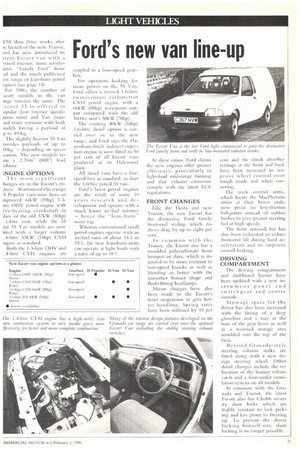Ford's new van line-up
Page 21

If you've noticed an error in this article please click here to report it so we can fix it.
ESS than three weeks after ic launch of the IlL'W Transit, ord has now introduced its itest Escort van with a wised interior. more aerodyantic "Family Fordfront rid itid the much publicised cw range of lean-burn petrol ngincs (see page 14).
For 1986, the number of scort models in the van Inge remains the same. The scort 35 is offered in 'opular (low interior specifiation trim) and Van (stanard trim) versions with both mdels having a payload of pti.500kg.
The slightly heavier 55 Van TOVidcs payloads of up to 004 — depending on speci[cation. The new models resin a 2.24)113 (801-0) load .olurne.
HNIGINE OPTIONS '1 he most significant hangcs are in the Escort's en;ines. Hottom-of-the-range
Popular vans now have an mproved 44kW (594) itre OHV petrol engine with lye-bearing crankshaft in ilace of the old 37kW (50hp) .1-litre unit, while the 35 ,nd 55 Van models are now itted with a larger volume .4-litre 55kW (74hp) CVH .ngine as standard.
Both the 1.3-litre OHV and ..4-litre CVII engines arc coupled to a ftmr-speed gearbox.
For operators looking for more power on the 55 Van, Ford offers a revised 1.6-litre twin-vellum carburettor CV' I petrol engine with a 66kW (88hp) maximum output compared with the old 1600cc unit's 58kW (78hp).
The existing 40kW (544) 1.6-litre diesel option is carried over on to the new range, and Ford says the Dagenham-built indirect-injection engine is now fitted to 50 per cent of all Escort vans produced at its Halewood
All diesel vans have a fivespeed box as standard, as does the 1,600cc petrol 55 van.
Ford's latest petrol engines arc the result of some 10 years research and development and operate with a much leaner air/fuel mixture — hence the "lean-burnname tag.
Whereas conventional small petrol engines operate with au air/filel ratio of about 14:1 or 15:1, the new lean-buns units can operate at light loads with a ratio of up to 18:1. At these ratios, Ford claims the new engines offer greater efficiency, particularly in light-load mid-range running and that exhaust emissions comply with the latest ECE regulations.
FRONT CHANGES
Like the Fiesta and new Transit, the new Escort has the distinctive Ford family front-end styling which reduces drag by up to eight per cent.
In common with the
ransit, the Escort also has A moulded polycarbonate front bumper/air dam, which is intended to he more resistant to low-speed knocks as well as blending in better with the smoother bonnet shape and flush-fitting headlamps.
Minor changes have also been made to the Escort's front suspension to give better handling. Spring rates have been stiffened by 10 per cent and the shock absorber settings at the front and back have been increased to improve wheel control over rough roads and when cornering, The track control arms, which locate the MacPherson Struts at their lower ends, now pivot on low-friction hall-joints instead of rubber hushes to give greater steering feel at high speeds.
The front anti-roll bar has also been re-located to reduce front-end lift during hard acceleration and to improve overall braking.
DRIVING COMPARTMENT
The driving compartment and dashboard layout have been updated with a new ins t rumen t panel and switchgear and centre console.
Stowage space for the driver has also been increased with the fitting of a deep glovebox and a tray at the base of the gear lever as well as a recessed storage area moulded into the top of the facia. .
Revised Granada-style steering column stalks are fitted along with a new design steering wheel. Other detail changes include the relocation of the bonnet release catch and a four-outlet ventilation system on all models.
In common with the Granada and Transit, the latest Escort also has Chubb security door locks which are highly resistant to lock picking and less prone to freezing up. To prevent the driver locking himself' out, slam locking is no longer possible.




















































